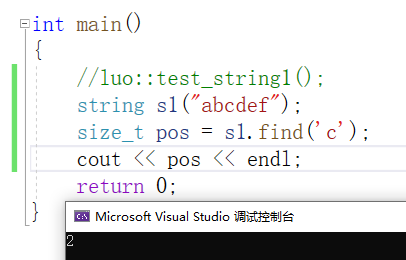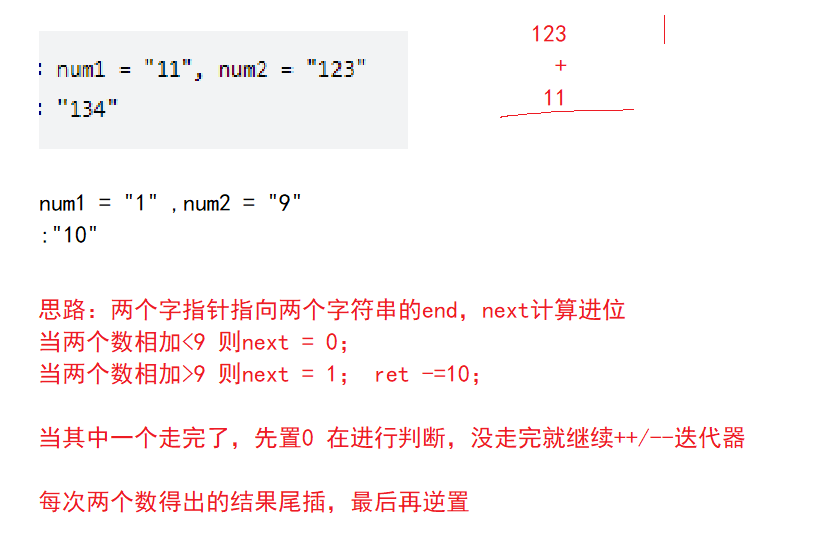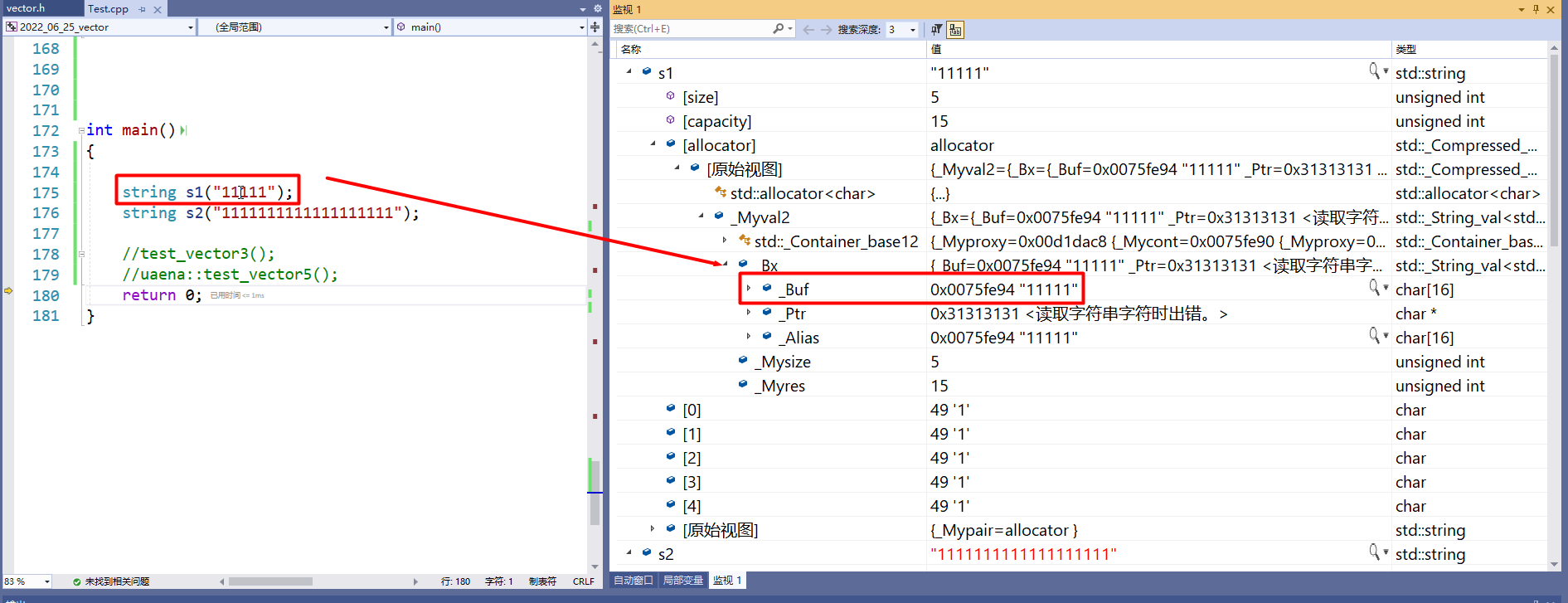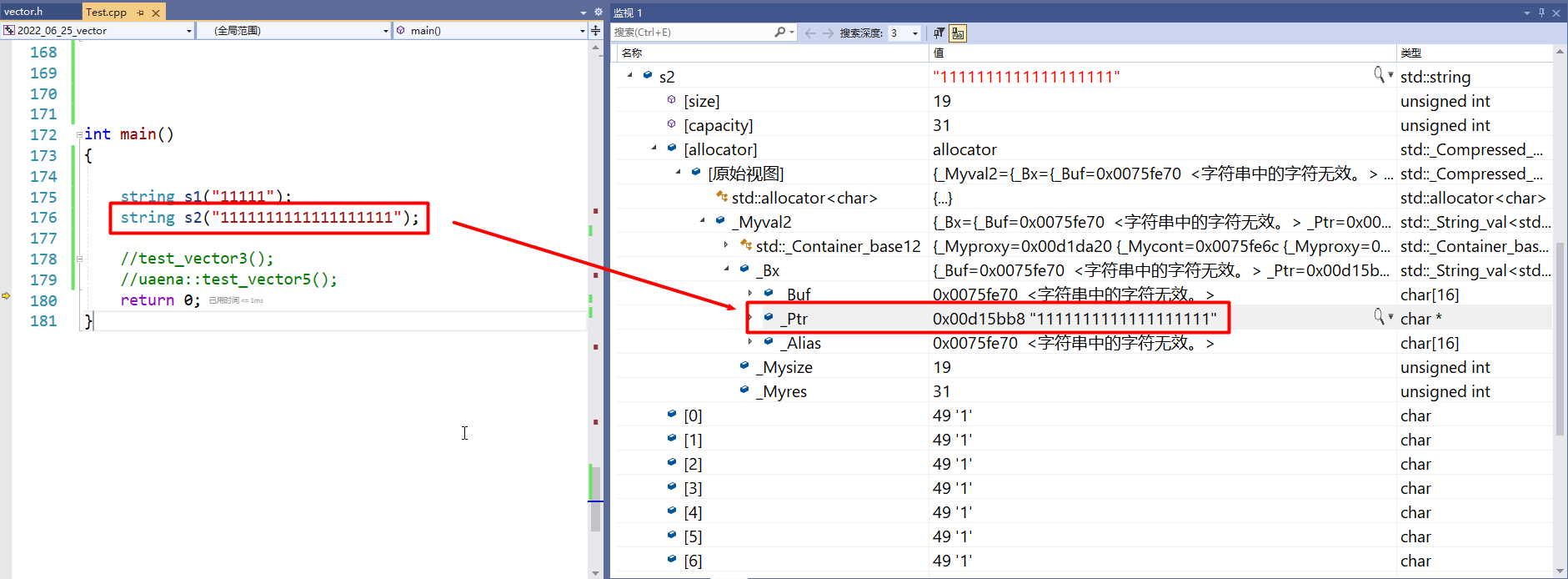string
模板:
泛型编程
函数模板
模板关键字:tmplate<calss T> //T可以随意改
template<class T> //template<typename T> 模板参数列表 - 参数类型
void Swap(T& x1, T& x2) //函数参数列表 - 参数对象
{
T x = x1;
x1 = x2;
x2 = x;
}
传入不同的类型 会调用不同的实例化函数
多个类型:
template<class T1,class T2>
模板实例化
调用Swap时 会实例化出不同类型的函数
实例化:是指在面向对象的编程中,把用类创建对象的过程称为实例化。 是将一个抽象的概念类,具体到该类实物的过程。 实例化过程中一般由类名对象名= new 类名(参数1,参数2…参数n)构成。
函数模板的实例化
template<class T>
T Add(const T& left, const T& right)//做返回值 和
{
return left + right;
}
int main()
{
int a1 = 10, a2 = 20;
double d1 = 10.1, d2 = 20.2;
cout << Add(a1, a2) << endl;
cout << Add(d1, d2) << endl;
cout << Add((double)a1, d2) << endl;
//显示实例化
cout << Add<int>(d1, d2) << endl; //指定类型
cout << Add<double>(d1, d2) << endl;
return 0;
}
结果:
30
30.3
30.2
30
30.3
如果函数模板 和 普通函数 同时存在,优先使用普通函数
类模板
一个栈类型 只能是 int 或 double 或…
定义对象只能满足 int栈 或者double栈
想要存储多个类型 则需要建多个不同类型的 类
template<class T>
class Stack
{
privvate:
T* _a;
int _top;
int _capacity;
}
int main()
{
Stack<int> st1;//存储int
Stack<double> st2;//存储double
}
STL:
S标准T模板L库
Vue - 前端贡献:尤雨溪
书籍推荐
《STL源码剖析》《effcrive C++》 继承多态学完看 《高质量C++》现在看
STL 六大组件
算法、容器、迭代器、配接器、仿函数、空间配置器(内存池)
string 成员函数
c++文档:
https://cplusplus.com/
编码补充
编码 - 值 – 符号建立映射
ASCII码表 - 表示英文编码表
unicode - 表示全世界文字编码表 utf-8
gbk - 中文编码表
常用的string
- 赋值
| default (1) | string(); |
|---|---|
| copy (2) | string (const string& str); |
| substring (3) | string (const string& str, size_t pos, size_t len = npos); |
| from c-string (4) | string (const char* s); |
-
size:计算长度
Return length of string (public member function )
-
capacity:计算空间大小 不算\0 所以是15
Return size of allocated storage (public member function )
-
clear:清除string内容
Clear string (public member function )
-
Request a change in capacity (public member function )
-
operator[ ]:出错断言assert
Get character of string (public member function )
char& operator[] (size_t pos); const char& operator[] (size_t pos) const; 这里的引用返回时为了 修改返回对象读取 s1[i] = s1.operator[] 的重载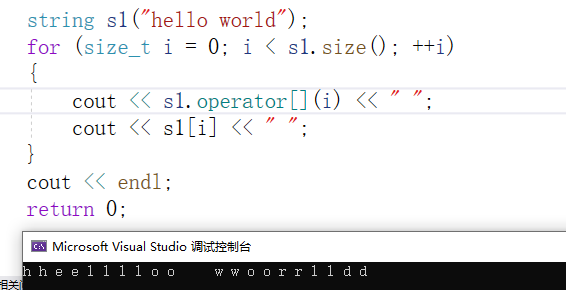
修改 s1[i]+=1;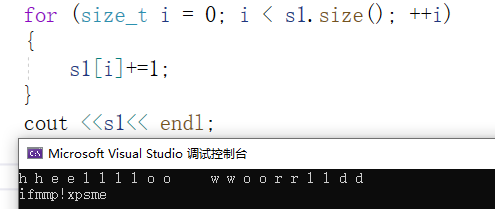
-
at:获取字符串的字符,出错抛异常
Get character in string (public member function)
-
operator+=:尾插字符或字符串
Append to string (public member function)
string s1; s1 += ':'; s1 += "hello world"; cout << s1 << endl; -
append:尾插字符串 不常用
Append to string (public member function)
-
push_back:尾插字符 不常用
Append character to string (public member function)
string s1;
s1.push_back('a');
s1.append("bcde");
cout << s1 << endl;
string 迭代器
//遍历+修改
//方式1:下标+[]
//返回对应位置的引用 可以直接修改s1[i]
for (size_t i = 0; i < s1.size(); ++i)
{
s1[i] += 1;
}
for (size_t i = 0; i < s1.size(); ++i)
{
cout << s1[i] << " ";
}
cout << endl;
迭代器想象成:像指针一样的类型
end()/begin()
typedef char*iterator;
typedef const char*const_iterator;
iterator begin();
const_iterator begin() const;
iterator end();
const_iterator end() const;
string s1("hello world");
//方式2:迭代器(iterator)
//begin()指的是第一个元素的位置 end()是最后一个元素的【下一个】
//it像指针一样指向第一个元素 ,可以解引用,可以++
string::iterator it = s1.begin();
while (it != s1.end())
{
*it -= 1;
++it;
}
it = s1.begin();//重置it的位置
while (it != s1.end())
{
cout << *it << " ";
++it;
}
cout << endl;
iterator begin();
范围for会替换成迭代器
//方式3:范围for 语法糖用起来很爽很甜
// C++11 linux:-std=c++11
//把s1中的值取出来 赋值给e 自动++
//for (char& e : s1)
for (auto& e : s1) //引用
{
e += 1;
}
for (auto e:s1)
{
cout << e << " ";
}
cout << endl;
const_iterator begin() const;
const 版本只能读取 不能修改
void func(const string& s1)
{
string::const_iterator it = s1.begin();
//auto it = s1.cbegin(); //cbegin()和cend()代表const
while (it != s1.end())
{
//*it -= 1; //不能修改
cout << *it << " ";
++it;
}
cout << endl;
}
rbegin() / rend(): 反向迭代器
reverse_iterator rbegin();
const_reverse_iterator rbegin() const;
- rbegin() 最后一个字符
- rebing()的 ++ 是向前走
- rend()是第一个字符的前一个
void test_string2()
{
string s1("hello world");
//反向迭代器
//rbegin() 指向最后一个字符
//
//反向++ 是逆向的
//string::reverse_iterator rit = s1.rbegin(); // string::reverse_iterator是类型
auto rit = s1.rbegin();//代替上面那句自动推到类型
while (rit != s1.rend())
{
cout << *rit << " ";
++rit;
}
cout << endl;
string cstr("hello world");
func(cstr);
}
c++11 新增const迭代器
迭代器的意义是什么?
所有的容器都可以使用迭代器这种方式去访问修改
答:
对于string,下标和[]就足够好用,确实可以不用迭代器。
其他容器(数据结构)呢?
(list、map/set 并不支持下标,只有数组才支持[],这些是链表和二叉树并不支持下标+[])
所以迭代器才是通用的方式
string 增容
测试代码
void TestPushBack()
{
string s;
//s.reserve(1000);//申请至少能存储10000个字符的空间 不一定是1000 要空间对其
size_t sz = s.capacity();
cout << "capacity changed: " << sz << '\n';
cout << "making s grow:\n";
for (int i = 0; i < 2000; ++i)
{
s.push_back('c');
if (sz != s.capacity())
{
sz = s.capacity();
cout << "capacity changed: " << sz << '\n';
}
}
}
结果
capacity changed: 15 //本质是16 但是没算\0 有效字符位置有15个
making s grow:
capacity changed: 31 //本质是32 但是没算\0 有效字符位置有31个
capacity changed: 47
capacity changed: 70
capacity changed: 105
capacity changed: 157
capacity changed: 235
reserve:扩容,只开空间
resize:扩容+初始化
开空间,并给初始值 进行初始化
如果resize扩容比已有数据少,则会删除多余数据,不会改变空间大小
reverse也不会缩容
void test_string3()
{
string s1;
s1.reserve(100);
//开空间并初始化
string s2;
//s2.resize(100); // 初始化的 \0
s2.resize(100,'x');//指定字符初始化
//resize不会把已有数据覆盖初始化,如果比已有数据小,则会除多余的数据
}
string 查找
c_str:返回C格式字符串
const char* c_str() const;
void test_string4()
{
string s("hello world");
cout << s << endl;//流插入 size是多少 打印多少
cout << s.c_str() << endl;//const char* 遇到\0结束
//应用场景 这里fopen的第一个参数需要const char*类型的字符串
string file("test.txt");
FILE* fout = fopen(file.c_str(), "w");
}
find:找位置
:从字符串pos位置开始往后找字符c,返回该字符在字符串中的下标
| string (1) | size_t find (const string& str, size_t pos = 0) const; |
|---|---|
| c-string (2) | size_t find (const char* s, size_t pos = 0) const; |
| buffer (3) | size_t find (const char* s, size_t pos, size_t n) const; |
| character (4) | size_t find (char c, size_t pos = 0) const; |
npos:-1
:size_t类型的 -1 一个很大的数
substr:查找字符串
:在str中从pos位置开始,截取n个字符,然后将其返回
string substr (size_t pos = 0, size_t len = npos) const;
string file("test.txt");
FILE* fout = fopen(file.c_str(), "w");
size_t pos = file.find('.');
if (pos != string::npos)//npos是 -1 size_t全1
{
//string suffix = file.substr(pos, file.size() - pos);
string suffix = file.substr(pos);//直接用默认缺省值 取到最后
cout << suffix << endl;
}
如果是连续后缀 ,要从右往左找
rfind:反向找
string file("test.txt.zip");
FILE* fout = fopen(file.c_str(), "w");
size_t pos = file.rfind('.');//这里用rfind
if (pos != string::npos)
{
string suffix = file.substr(pos);
cout << suffix << endl;
}
}
-
解析URL
string url("https://www.cplusplus.com/reference/string/string/rfind/"); //取协议 size_t pos1 = url.find(':'); string protocol = url.substr(0, pos1 - 0); cout << protocol << endl; //取域名 size_t pos2 = url.find('/',pos1+3);//冒号+3是w的位置开始找/ string domain = url.substr(pos1 + 3,pos2-(pos1+3)); cout << domain << endl; //取路径 string uri = url.substr(pos2 + 1);//从域名后的/ +1 的位置找到最后 cout << uri << endl; https www.cplusplus.com reference/string/string/rfind/
string 插入删除
insert:插入
| string (1)** | string& insert (size_t pos, const string& str); |
|---|---|
| substring (2) | string& insert (size_t pos, const string& str, size_t subpos, size_t sublen); |
| c-string (3) | string& insert (size_t pos, const char* s); |
| buffer (4) | string& insert (size_t pos, const char* s, size_t n); |
| fill (5)** | string& insert (size_t pos, size_t n, char c); void insert (iterator p, size_t n, char c); |
| single character (6)** | iterator insert (iterator p, char c); |
| range (7) | template <class InputIterator> void insert (iterator p, InputIterator first, InputIterator last); |
void test_string5()
{
string s("hello world");
s += ' ';//尾插
s += "!!!";
cout << endl;
//头插 效率低 O(N) 尽量少用
s.insert(0, 1, 'x');//在0的位置插入1个x
s.insert(s.begin(), 'y');//在头部插入y
s.insert(0, "test");//在0的位置插入test
cout << s << endl;
//中间位置插入,尽量少用
s.insert(4, "&&&&&&");
cout << s << endl;
}
erase:删除
| sequence (1)** | string& erase (size_t pos = 0, size_t len = npos); |
|---|---|
| character (2) | iterator erase (iterator p); |
| range (3) | iterator erase (iterator first, iterator last); |
void test_string6()
{
string s("hello world");
//尽量少用头部和中间的删除,效率低
s.erase(0,1);//删除头上的一个字符
s.erase(s.size()-1,1);//删除尾部的一个字符
cout << s << endl;
s.erase(3);//从第三个位置 后面全部删除
cout << s << endl;
}
operator+:加
字符串相加,返回新的字符串
// concatenating strings
#include <iostream>
#include <string>
main ()
{
std::string firstlevel ("com");
std::string secondlevel ("cplusplus");
std::string scheme ("http://");
std::string hostname;
std::string url;
hostname = "www." + secondlevel + '.' + firstlevel;
url = scheme + hostname;
std::cout << url << '\n';
return 0;
}
输出:http://www.cplusplus.com
getline:连续获取一行字符串
方法一的代码就是getline的原理,一个字符一个字符的获取!
| (1) | istream& getline (istream& is, string& str, char delim); |
|---|---|
| (2) | istream& getline (istream& is, string& str); |
#include <iostream>
using namespace std;
int main()
{
string s;
//cin>>s;//cin读到空格或换行结束 scanf同理
//方法一:一个字符一个字符拿
// char ch = getchar();
// //char ch = cin.get();
// while(ch!='\n')
// {
// s+=ch;
// ch = getchar();
// }
//方式二:
getline(cin,s);
size_t pos = s.rfind(' ');
if(pos == string::npos)
{
cout <<s.size()<<endl;
}
else{
cout << s.size() - pos-1;
}
return 0;
}
string 比较大小
relational operators:比较大小
| (1) | bool operator== (const string& lhs, const string& rhs); bool operator== (const char* lhs, const string& rhs); bool operator== (const string& lhs, const char* rhs); |
|---|---|
| (2) | bool operator!= (const string& lhs, const string& rhs); bool operator!= (const char* lhs, const string& rhs); bool operator!= (const string& lhs, const char* rhs); |
| (3) | bool operator< (const string& lhs, const string& rhs); bool operator< (const char* lhs, const string& rhs); bool operator< (const string& lhs, const char* rhs); |
| (4) | bool operator<= (const string& lhs, const string& rhs); bool operator<= (const char* lhs, const string& rhs); bool operator<= (const string& lhs, const char* rhs); |
| (5) | bool operator> (const string& lhs, const string& rhs); bool operator> (const char* lhs, const string& rhs); bool operator> (const string& lhs, const char* rhs); |
| (6) | bool operator>= (const string& lhs, const string& rhs); bool operator>= (const char* lhs, const string& rhs); bool operator>= (const string& lhs, const char* rhs); |
void test_string7()
{
string s1("hello world");
string s2("string");
const char* ps = "char";
cout << (s1 < s2) << endl;//1
cout << (s1 < ps) << endl;//0
cout << ("hhh" < s2) << endl;//1
cout << (s1 < "sss") << endl;//1
}
C++11 补充
stoi :str转int
int stoi (const string& str, size_t* idx = 0, int base = 10);
int stoi (const wstring& str, size_t* idx = 0, int base = 10);
int val = stoi("1234");
cout << val << endl;
to_string :int 转 str
string to_string (int val);
string to_string (long val);
string to_string (long long val);
string to_string (unsigned val);
string to_string (unsigned long val);
string to_string (unsigned long long val);
string to_string (float val);
string to_string (double val);
string to_string (long double val);
string str = to_string(3.14);
cout << str << endl;//3.140000
练习题
125. 验证回文串
class Solution {
public:
bool isLeterOrNumber(char ch)
{
if(ch>='0' && ch<='9')
return true;
if(ch>= 'a' && ch<='z')
return true;
if(ch>='A' && ch<= 'Z')
return true;
return false;
}
bool isPalindrome(string s) {
int begin = 0,end = s.size()-1;
while(begin<end)
{
while(begin<end && !isLeterOrNumber(s[begin]))
++begin;
while(begin<end && !isLeterOrNumber(s[end]))
--end;
if(tolower(s[begin]) != tolower(s[end]))
return false;
++begin;
--end;
}
return true;
}
};
415. 字符串相加
class Solution {
public:
string addStrings(string num1, string num2) {
int end1 = num1.size()-1;int end2 = num2.size()-1;
int next = 0;//计算进位
string retStr;
while(end1>=0 || end2>=0)
{
int X1 = 0;
if(end1>=0)
{
X1 = num1[end1]-'0';
--end1;
}
int X2 = 0;
if(end2>=0)
{
X2 = num2[end2]-'0';
--end2;
}
int retVal = X1 + X2 + next;
if(retVal > 9)
{
next = 1;
retVal -= 10;
}
else
{
next = 0;
}
retStr += retVal+'0';
}
if(next == 1)
{
retStr += '1';
}
reverse(retStr.begin(),retStr.end());
return retStr;
}
};
两个swap的区别?
string::swap:string专属
void swap (string& str);
std::swap:全局
适用于内置类型
template <class T> void swap ( T& a, T& b )
{
T c(a); a=b; b=c;
}
区别:
string::swap 对于string效率高,只交换资源,改变指针的指向
std::swap 对于string会拷贝构造c (深拷贝1)、a=b(深拷贝2)、b=c(深拷贝3) 进行三次string的深拷贝,代价极高
浅拷贝问题
1.浅拷贝会析构两次
2.期中一个对象进行修改会影响另一个
引用计数(解决浅拷贝)
如果对象不修改,则只增加了引用计数,不进行深拷贝,提高了效率
缺陷:引用计数存在线程安全问题,需要加锁,在多线程环境下要付出代价,在动态库、静态库中有些场景也会存在问题
当一块空间有多个指针指向,则会增加引用计数,例如2个指针指向 ,则引用计数是2
当指针析构的时候,引用计数不是1 则 会减减引用计数,直到只有一个指针的时候才析构
? 也就是说10指针指向a,前9个指着都不会析构a空间,只会减减引用计数,只有最后一个指针会析构a空间
写时拷贝
insert/+=/erase等函数中,先查看引用计数,如果引用计数不是1,要先进性深拷贝,再去修改
当引用计数不是1 ,则进行写实拷贝,因为这块空间不是一个指针维护,所以不能修改
开区间取值
0 - 9 的下标是10个有效字符
所以算有效字符是size - 0 (size是最后一个字符的下一个)
string 补充:vs下
class string
{
private:
char _Buf[16]; //字符长度小于16,就存在这个数组_Buf中
char* _Ptr; //大于等于16,就会去堆上申请,存在_Ptr中
size_t _mySize;
size_t _myRes;
}
sizeof() //28字节
